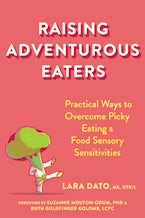By Lara Dato, MS, OTR/L, author of Raising Adventurous Eaters
The holidays are just around the corner. Holidays are times for family, tradition, and food. For picky eaters and their families though, holiday meals can be full of stress and anxiety. Here are some ideas to set your child up for success during this holiday season’s meals, and to ensure you and your family have a peaceful and positive holiday meal experience.
How to prepare:
- If you can, let your child practice trying and tasting your traditional holiday foods ahead of time. Holiday meals are often full of new or infrequently served foods. This can feel daunting and overwhelming for picky eaters. Anxiety can decrease appetite and willingness to try new foods. Increased familiarity with holiday foods and recipes will help set them at ease, and make them more likely to branch out with their food choices.
- Creating a sense of predictability will help them know what to expect. Talk with them about what foods might be offered, and how they may want to contribute or get involved in the meal. Set any expectations before the big meal, rather than on the day of, to help avoid big tantrums.
- If you’re preparing foods before the big day, get your child involved by letting them help. They could help stir, pour, taste-test, or even just watch! This will give them a chance to explore and learn about these foods from the comfort of home, before they have the pressure of the watchful eyes of their extended family.
During the meal:
- Plan to serve at least one familiar side dish (and offer it to the whole family!). This allows your child to feel secure and comfortable with something that’s on their plate, without feeling singled out. It also gets them started eating. Once they start, it’s often easier to keep going (and they might even try something new!).
- If your child is really picky, try putting only one or two new foods on their plate along with foods you know they’ll like. Higher quantities of non-preferred foods can decrease their willingness to try new foods, because they feel more overwhelming. One or two new or non-preferred foods feel much more attainable for them than four or five, and they’ll be more likely to dig in.
- It can also help to offer very small servings of non-preferred foods. Kids are more likely to taste foods if they’re served smaller portions of those foods rather than larger ones. Plus, it can lead to less food waste! For picky eaters, an initial serving size of a non-preferred food could be as small as a quarter of a teaspoon. They can always get additional servings if they want.
- If your child is willing (and your family does family style meals), encourage them to serve themselves. Taking ownership of their own plate can help increase buy-in. You can guide them by setting clear and attainable expectations. For example: “You will put at least one new food on your plate.”
- Set a good example for your children. Show them with your own behavior how to try a wide variety of foods (even if they’re not your favorite either!). It’s beneficial for children to understand that even adults have non-preferred foods, but that everyone can learn to like a new food!
- Unplug—no phone or tablet at the dinner table. Distractions limit their engagement in the social aspect of the meal, and from the important aspects of learning and trying new foods.
After the meal:
- Find something positive that you can give your child a compliment about, whether that’s trying a new food, putting something new on their plate, or participating in the family conversation. These experiences can be stressful, and it’s helpful to end on a positive note. This will help them remember the experience fondly, and to feel confidence in themselves, which will make them more likely to try something new in the future.
- Save leftovers for practicing—children need to try foods an average of fifteen times before they can learn to like them. Getting extra opportunities to taste foods can set them up for success for the next holiday season.
Happy holidays and happy eating!
Lara Dato, MS, OTR/L, is a pediatric occupational therapist with a specialty certification in feeding, eating, and swallowing—one of approximately fifty professionals with these credentials in the US. In addition to years as a feeding therapist, she has taught courses on feeding therapy across the country. Her passion is helping picky eaters and their families find joy in adventurous eating!



 Part 2: What to Do When a Client Is Participating in Self-Judgment?
Part 2: What to Do When a Client Is Participating in Self-Judgment?